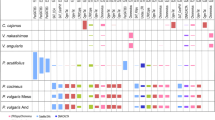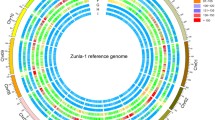Abstract
SixBrassica species, known as the “triangle of U”, and four species from related genera were characterized by DNA fingerprinting with simple repetitive oligonucleotide probes. Our results show that CT-, TCC-, and GTG-repeat motifs are equally abundant in the genomes of the sixBrassica species. In contrast, GATA-, GGAT-, and GACA-multimers are unevenly distributed among different species. As judged from the number and strength of hybridization signals, the highest copy number of all three motifs occurs inBrassica nigra, while the lowest is observed inB. oleracea. The abundance of GATA-and GACA-repeats varies in a coordinate way. The amphidiploid genomes ofB. juncea, B. carinata, andB. napus each harbour intermediate amounts of (GATA)4 and (GACA)4-detected repeats as compared to their diploid progenitors, thus supporting the concept of the “U triangle”. GATA-, GACA-, and GGAT-repeats were also abundant inEruca sativa andSinapis arvensis, but not inRaphanus sativus andSinapis alba. These results support the idea thatBrassica nigra is more closely related toSinapis arvensis than to otherBrassica species such asB. rapa andB. oleracea.
Similar content being viewed by others
References
Ali, S., Müller, C. R., Epplen, J. T., 1986: DNA fingerprinting by oligonucleotide probes specific for simple repeats. — Hum. Genet.74: 239–243.
Attia, T., Röbbelen, G., 1986: Cytogenetic relationship within cultivatedBrassica analysed in amphihaploids from the three diploid ancestors. — Canad. J. Genet. Cytol.28: 323–329.
Chen, B. Y., Heneen, W. K., Simonsen, V., 1989: Comparative and genetic studies of isozymes in resynthesized and cultivatedBrassica napus L.,B. rapa L., andB. alboglabra Bailey. — Theor. Appl. Genet.77: 673–679.
Chyi, Y.-S., Hoenecke, M. E., Sernyk, J. L., 1992: A genetic linkage map of restriction fragment length polymorphism loci forBrassica rapa (syn.campestris). — Genome35: 746–757.
Delseny, M., McGrath, J. M., This, P., Chevre, A. M., Quiros, C. F., 1990: Ribosomal RNA genes in diploid and amphidiploidBrassica and related species: organization, polymorphism, and evolution. — Genome33: 733–744.
Epplen, J. T., 1988: On simple repeated GATA/GACA sequences in animal genomes: a critical reappraisal. — J. Heredity79: 409–417.
Grellet, F., Delcasso, D., Panabières, F., Delseny, M., 1986: Organization and evolution of a higher plant alphoid-like satellite DNA sequence. — J. Mol. Biol.187: 495–507.
Gupta, V., Jagannathan, V., Lakshmikumaran, S., 1990: A novel AT-rich tandem repeat ofBrassica nigra. — Pl. Sci.68: 223–229.
—, 1992: Characterization of species-specific repeated DNA sequences fromB. nigra. — Theor. Appl. Genet.84: 397–402.
Harbinder, S., Lakshmikumaran, M., 1990: A repetitive sequence fromDiplotaxis erucoides is highly homologous to that ofBrassica rapa andB. oleracea. — Pl. Mol. Biol.15: 155–156.
Hosaka, K., Kianian, S. F., McGrath, J. M., Quiros, C. F., 1989: Development and chromosomal localization of genome-specific DNA markers ofBrassica and the evolution of amphidiploids and n = 9 diploid species. — Genome33: 131–142.
Iwabuchi, M., Itoh, K., Shimamoto, K., 1991: Molecular and cytological characterization of repetitive DNA sequences inBrassica. — Theor. Appl. Genet.81: 349–355.
Kaemmer, D., Afza, R., Weising, K., Kahl, G., Novak, F. J., 1992: Oligonucleotide and amplification fingerprinting of wild species and cultivars of banana (Musa spp.). — Bio/Technology10: 1030–1035.
Lakshmikumaran, M., Ranade, S. A., 1990: Isolation and characterization of a highly repetitive DNA ofBrassica rapa. — Pl. Mol. Biol.14: 447–448.
Levinson, G., Gutman, G. A., 1987: Slipped strand mispairing: a major mechanism for DNA sequence evolution. — Mol. Biol. Evol.4: 203–221.
McGrath, J. M., Quiros, C. F., Harada, J. J., Landry, B. S., 1990: Identification ofBrassica oleracea monosomic alien chromosome addition lines with molecular markers reveals extensive gene duplication. — Mol. Gen. Genet.223: 198–204.
Palmer, J. D., 1988: Intraspecific variation and multicircularity inBrassica mitochondrial DNAs. — Genetics118: 341–351.
—, 1983: Chloroplast DNA evolution and the origin of amphidiploidBrassica species. — Theor. Appl. Genet.65: 181–189.
Poulsen, G. B., Kahl, G., Weising, K., 1993: Abundance and polymorphism of simple repetitive DNA sequences inBrassica napus L. — Theor. Appl. Genet.85: 994–1000.
Pradhan, A. K., Prakash, S., Mukhopadhyay, A., Pental, D., 1992: Phylogeny ofBrassica and allied genera based on variation in chloroplast and mitochondrial DNA patterns: molecular and taxonomic classifications are incongruous. — Theor. Appl. Genet.85: 331–340.
Prakash, S., Hinata, K., 1980: Taxonomy, cytogenetics, and origin of crop Brassicas, a review. — Opera Bot.55: 1–57.
Reddy, A. S., Srivastava, V., Guha-Mukherjee, S., 1989: A tandemly repeated DNA sequence fromBrassica juncea. — Nucl. Acids Res.17: 5849.
Röbbelen, G., 1960: Beiträge zur Analyse desBrassica-Genoms. — Chromosoma11: 205–228.
Schmidt, T., Jung, C., Metzlaff, M., 1991: Distribution and evolution of two satellite DNAs in the genusBeta. — Theor. Appl. Genet.82: 793–799.
Sibson, D. R., Hughes, S. G., Bryant, J. A., Fitchett, P. N., 1991: Sequence organization of simple, highly repetitive DNA elements inBrassica species. — J. Exp. Bot.42: 243–249.
Slocum, M. K., Figdore, S. S., Kennard, W. C., Suzuki, J. Y., Osborn, T. C., 1990: Linkage arrangement of restriction fragment length polymorphism loci inBrassica oleracea. — Theor. Appl. Genet.80: 57–64.
Song, K., Osborn, T. C., Williams, P. H., 1988:Brassica taxonomy based on nuclear restriction fragment length polymorphisms (RFLPs). 1. Genome evolution of diploid and amphidiploid species. — Theor. Appl. Genet.75: 784–794.
—, 1990:Brassica taxonomy based on nuclear restriction fragment length polymorphisms (RFLPs). 3. Genome relationships inBrassica and related genera and the origin ofB. oleracea andB. rapa (syn.rapa). — Theor. Appl. Genet.79: 497–506.
—, 1991: A linkage map ofBrassica rapa (syn.campestris) based on restriction fragment length polymorphism loci. — Theor. Appl. Genet.82: 296–304.
Tautz, D., Renz, M., 1984: Simple sequences are ubiquitous repetitive components of eukaryotic genomes. — Nucl. Acids Res.12: 4127–4138.
U, N., 1935: Genome analysis inBrassica with special reference to the experimental formation ofB. napus and peculiar mode of fertilization. — Japan J. Bot.7: 389–452.
Warwick, S. I., Black, L. D., 1991: Molecular systematics ofBrassica and allied genera (subtribeBrassicinae, Brassicae) — chloroplast genome and cytodeme congruence. — Theor. Appl. Genet.82: 81–92.
—, 1992: Molecular systematics ofBrassica and allied genera (subtribeBrassicinae, Brassicae) — chloroplast DNA variation in the genusDiplotaxis. — Theor. Appl. Genet.83: 839–850.
Weising, K., Weigand, F., Driesel, A., Kahl, G., Zischler, H., Epplen, J. T., 1989: Polymorphic simple GATA/GACA repeats in plant genomes. — Nucl. Acids Res.17: 10128.
—, 1991: Plant DNA fingerprinting with radioactive and digoxigenated oligonucleotide probes complementary to simple repetitive sequences. — Electrophoresis12: 159–169.
—, 1992: Oligonucleotide fingerprinting reveals various probe-dependent levels of informativeness in chickpea (Cicer arietinum). — Genome35: 436–442.
Xia, X., Selvaraj, G., Bertrand, H., 1993: Structure and evolution of a highly repetitive DNA sequence fromBrassica napus. — Pl. Mol. Biol.21: 213–224.
Author information
Authors and Affiliations
Rights and permissions
About this article
Cite this article
Poulsen, G.B., Kahl, G. & Weising, K. Differential abundance of simple repetitive sequences in species ofBrassica and relatedBrassicaceae . Pl Syst Evol 190, 21–30 (1994). https://doi.org/10.1007/BF00937856
Received:
Revised:
Accepted:
Issue Date:
DOI: https://doi.org/10.1007/BF00937856




